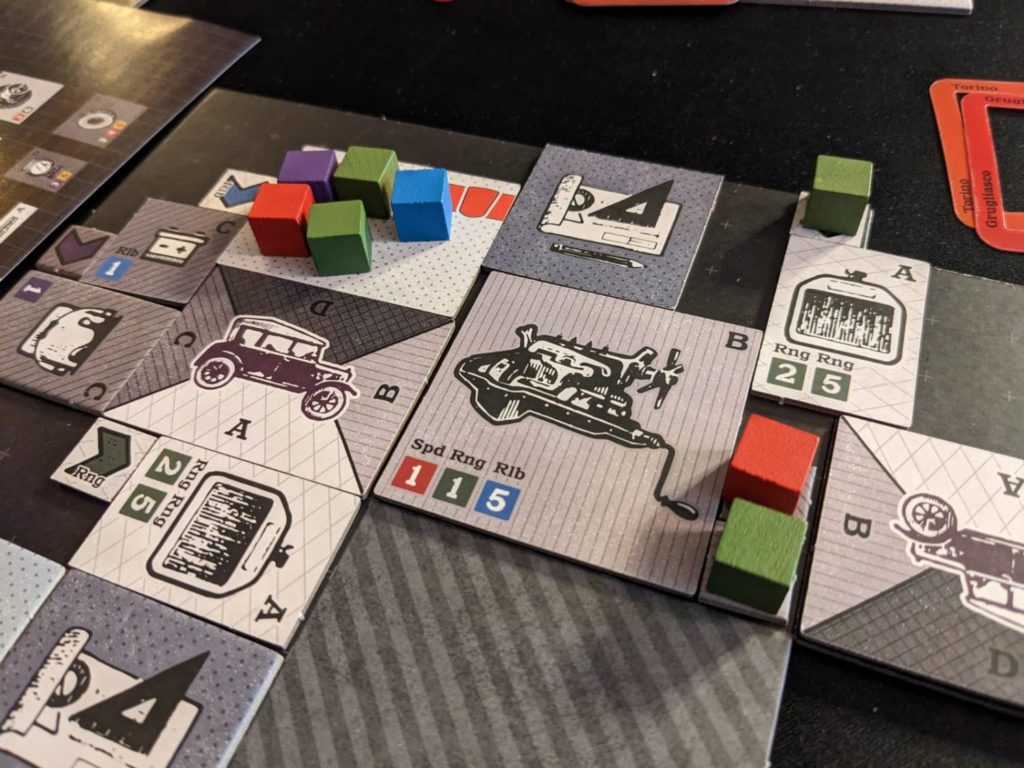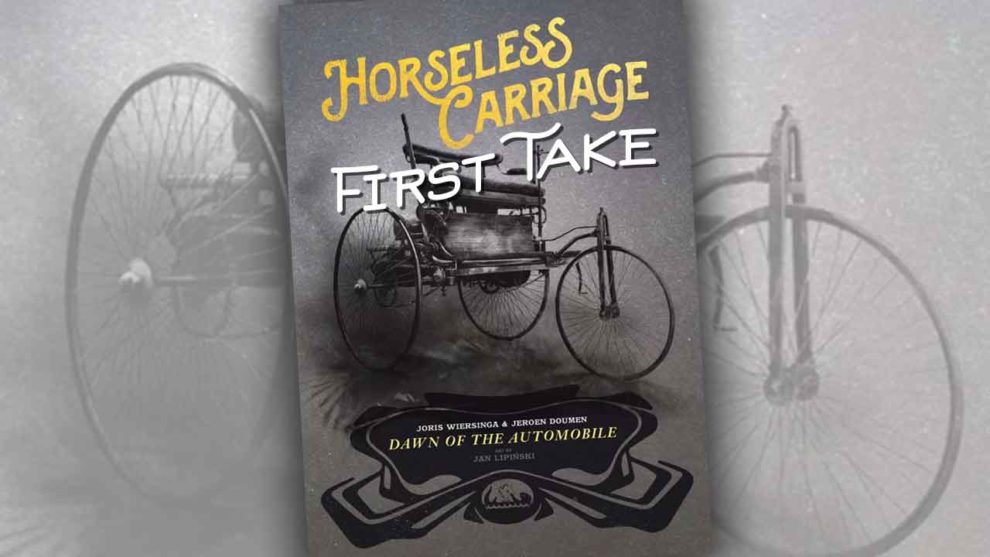I was tossing around options for a game night with my heavy strategy group recently. I threw out some mid-weight fare; Euros like Hansa Teutonica Big Box and Findorff, or maybe an economic thriller such as Magnate: The First City.
My buddy Johnivan had another idea to check the box on something heavier: “How about Horseless Carriage?”
I was curious about the newest Splotter Spellen design. Jeroen Doumen and Joris Wiersinga have designed some of what I believe are the most polarizing games of the last 15 years, most famously with Food Chain Magnate but also with games such as Indonesia, The Great Zimbabwe, and Antiquity.
Generally speaking, everyone I know either loves Splotter games, or they hate Splotter games. Most people recognize the design chops, though; the games are always interesting, even if they bounce off of some players.
I’m generally in the “hate” camp, if only because I haven’t loved any of the Splotter games I have tried. Splotter experiences can be quite harsh during a first play, because they are usually longer games for new players and because you may find yourself completely out of the competitive portion of play very early on.
I have had the chance to play a few Splotter games: I didn’t mind Bus, I thought Indonesia was interesting but not for me, and Food Chain Magnate was an unmitigated disaster. None of that would stop me from playing Horseless Carriage, because I’m always curious to see how the Splotter team will approach a new theme and I like cars.
As I learned during my first play of Horseless Carriage, my brain has a limit to the number of tile-laying decisions it can make in a single three-hour game.

Eight Phases, But Only One That Matters
Horseless Carriage is a simulation of sorts; how would new car makers make cars without really being sure about what customers want in an automobile?
So let’s pretend it’s the early 1900s. Over the course of a number of rounds, players have to produce cars and sell them to a slowly growing market of prospective customers. Players will sell these cars by producing vehicles with features that the current market of buyers wants, which might change a bit from year to year.
Each round is made up of eight phases. Many of these are purely administration, while a couple set and manipulate turn order. Near the end of a round, all players help set the market for vehicles in the next round. In my single play of Horseless Carriage, as well as the teach video that I watched to learn the game, it feels like only one of the eight phases is critical to a player’s success or failure: Build Factory.
During this segment, players concurrently pull from the pool of more than 30 individual tiles—“mainlines” (car production ports), car parts, spec indicators, dealerships, planning tiles, and/or research tiles to build out parts of their small factory. There are almost no rules during this sequence; if someone has previously researched a technology themselves, they can build it, and depending on turn order, they may be able to build even more by accessing the technology of the most advanced player in a particular area of features that round.
Now, I say that there are “no rules” during this sequence, but of course there are a lot of rules, starting with the number of edge cases involved. Horseless Carriage is essentially the Build Factory phase, so buckle up. If you don’t enjoy Tetris or more advanced polyomino experiences, Horseless Carriage immediately becomes a game that is not for you. Even if you do enjoy tile-laying games, you get to learn the #1 rule about Splotter games:
“If you can’t lose a game on the first turn, what’s the point of having a first turn?”
A few people I spoke to about Horseless Carriage had something terrible happen on their first turn, and it happened to me as well. I tried to build a car that needed all kinds of features, but the way tiles have to be laid on your factory board, I covered up one of the sides of my first mainline, which eliminated the ability to add more safety, reliability, speed, range, and/or design features later.
Then, by round three, I broke a rule regarding having multiple “mainlines” so I didn’t sell any cars in a round. Game over. Unfortunately, we were four rounds from the ending, so I got to sit and mostly watch the majority of a three-hour game.
Splotter.

That Said,
I can see why some players really like Horseless Carriage. It starts with the investment; even during my first play, I could see how players would enjoy the manipulation of how features are, well, featured during each round’s sales process. Turn order is massive in Horseless Carriage; while that’s not the meat of the game, it’s the trigger to being able to sell $30 worth of trucks (in my experience, this was a lot for a single turn) late in the game when only one market space has that much truck value lying around for someone to score.
There are a lot of layers to the polyomino elements. While this game might not be for me, I have a few friends who love polyomino experiences. Enjoy the pipeline-building aspects of Pipeline, or building your player board in A Feast for Odin? Horseless Carriage might be for you. It’s also a brutal, eat-or-be-eaten sales game, which I normally like, and there are lots of ways to manipulate how that process works.
The production of Horseless Carriage is generally average, which is better than my memories of the production level of Food Chain Magnate. The board, the components, and the rules are all fine…well, they are mostly fine, at least when they are not fiddly.
I am surprised to report that the theme in Horseless Carriage really didn’t play into my feelings on the game. It’s a game about cars, but not really. It’s a game about building out a car factory, but that’s also not really true—it’s Tetris with a lot more rules. (I like to swim in those lighter game polyomino waters, with games like Tenpenny Parks.) Although I hoped Horseless Carriage would be rich in history, interesting moments, and major events, that all washes away once the game begins.
I enjoyed the push/pull of turn order, particularly in the early rounds as players have to decide whether to prioritize engineering (which gives the first player a technology edge when adding car features) or sales (which gives the last player in turn order the right to poach cars from the market first). By round five or six—Horseless Carriage has a “punch clock” that slowly ticks down during player-driven actions, which could end the game before its seven-round maximum—everyone’s cars are likely built out so sales becomes the priority.

Now, About Those Fiddly Bits
I picked up a game called Autobahn last year at SPIEL. At the time, I was sure that it was the most “fiddly” game, in terms of components and rules, I had played since joining the Meeple Mountain team. Autobahn has a bunch of small cardboard chits that get pushed around with ease, trucks that need to sit firmly on built road tiles but don’t, and a few rules that can best be described as “a massive PITA.” (I’ll let you dig around for the definition on that acronym.)
But then I played Horseless Carriage, and we now have a new leader in the realm of fiddly.
Let’s start with the components. Each player will be able to add dealerships to their factories, which allows them to sell the car types attached to that dealership. When selling cars, each player places a “market window” to show the range in which they can corner a market. These market windows are made of what might be the flimsiest plastic I’ve ever used in a board game.
But, I don’t actually mind how cheap they feel. I DO mind how much they move on the market board whenever a table gets bumped. I really minded it late in the game, because players can drop market windows over each other, and by the end of a four-player game, there might be 10-12 market windows on the grid.
Yikes.
Did I mention that inside of each individual square on the board, there might be tiny chits, known as sparks, that indicate where demand will permanently grow between rounds? Those market windows might nudge some of the sparks, creating even more chaos.
(I have to acknowledge here one of the funniest video clips of the year. Our peers at Shut Up and Sit Down did a review of Horseless Carriage, and this clip will tell you all you need to know about how fiddly some of these bits are. Oh my goodness, the spec indicators on the factory board just seem to always be moving!!)
Does this break the game? I don’t think so, but it’s enough that it needs to be addressed here. Again, Splotter games are the opposite of, say, an Eagle-Gryphon Games production. You aren’t getting triple-layered player boards, or the car pieces from Kanban EV, or an impressive overview of the time period in a separate manual to set the context. You are getting an upgraded print-and-play game, one that fits well for gamers who can look past these elements and are willing to drop $125 on a new game.

Will I Play It Again?
Despite all of my nitpicks, Horseless Carriage is a game that I would be open to playing a second time. I’m not great at connecting the dots on the polyomino elements here; while I love economic games, Horseless Carriage isn’t really an economic game in the way that even Food Chain Magnate feels.
But I can see how some of the most interesting elements around competition for the advanced vehicle types (trucks and sports cars) can swing the game. I like the control players have in how a game’s technology focus can favor some features over others, even if I got hosed during my single play.
After the game, I gave a second read to the rulebook; like other Splotter games, the main rules are straightforward. It’s the consequences for your actions that have long-lasting effects, so seeing your vision through from start to finish is such a big part of the challenge. For a dedicated group, I think Horseless Carriage will be a fun time.
I would be shocked if longtime Splotter fans think Horseless Carriage is the best of the Splotter designs, but I’m excited for individual players and other content creators to review the game in the months ahead.
The game is the game, but my version of the design would have more guardrails—more rules for the Build Factory phase, factory and sales expenses (nothing during play costs any money), plus a different way to pass time. Players in Horseless Carriage have a lot of freedom, and I wish there was slightly less of that freedom.
As usual, I’m glad I tried the game because I was very curious. We’ll see if I give it another spin in the future!












My group hated this game. It’s mostly admin and then you have a mountain of tiny squares all bopping around the table in a drab pile of boring theme. The squares for selling stuff knock things around and in general its just difficult to move anything around. And yes, unless you know the game you’ll probably box yourself out almost immediately and then waste the rest of your whole turn. We like heavy games but this game is just bad.